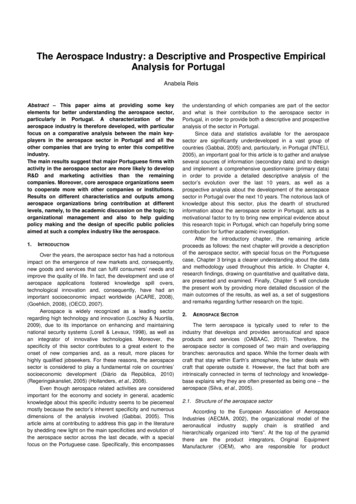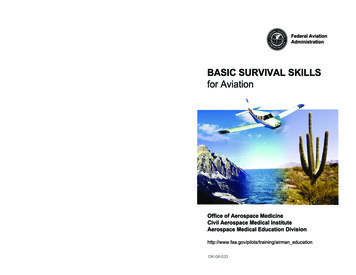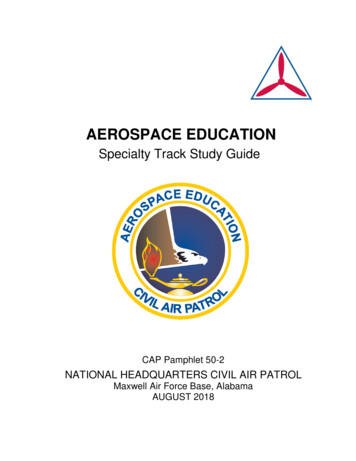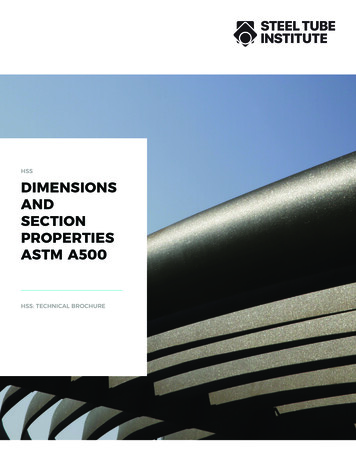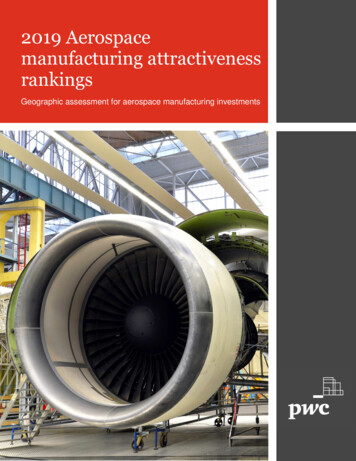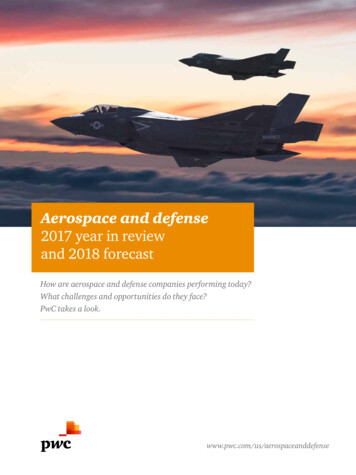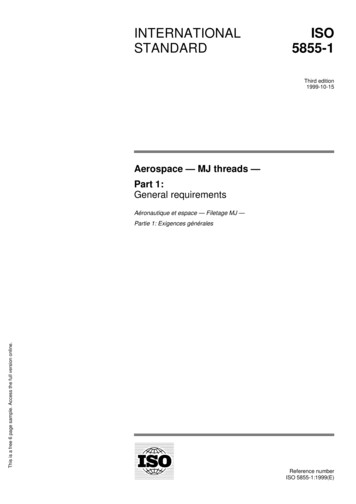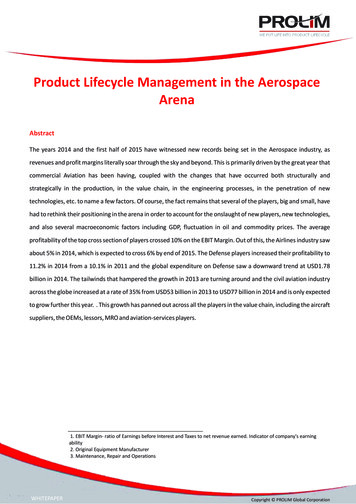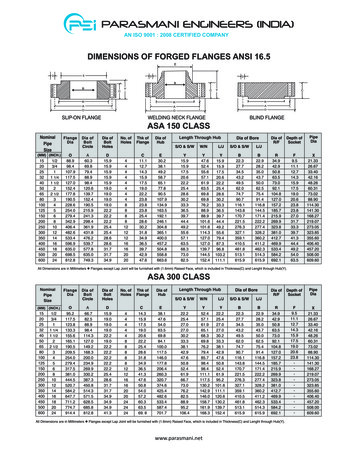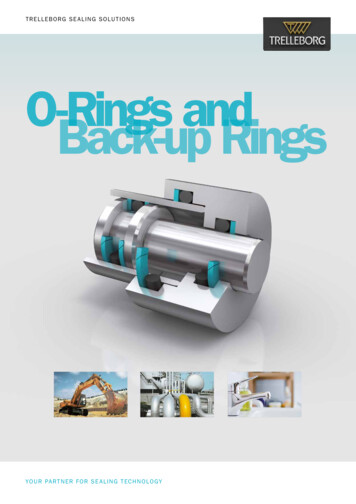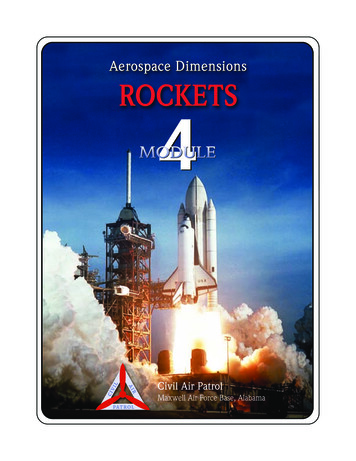
Transcription
Aerospace DimensionsROCKETS4MODULECivil Air PatrolMaxwell Air Force Base, Alabama
Aerospace DimensionsROCKETS4WRITTEN BYDR. JEFF MONTGOMERYDR. BEN MILLSPAUGHDESIGNBARB PRIBULICKILLUSTRATIONSPEGGY GREENLEEEDITINGBOB BROOKSSUSAN MALLETTJUDY STONENATIONAL ACADEMIC STANDARD ALIGNMENTJUDY STONEPUBLISHED BYNATIONAL HEADQUARTERSCIVIL AIR PATROLAEROSPACE EDUCATION DEPUTY DIRECTORATEMAXWELL AFB, ALABAMA 36112SECOND EDITIONSEPTEMBER 2010
INTRODUCTIONThe Aerospace Dimensions module, Rockets, is the fourth of six modules, which combined, makeup Phases I and II of Civil Air Patrol's Aerospace Education Program for cadets. Each module ismeant to stand entirely on its own, so that each can be taught in any order. This enables new cadetscoming into the program to study the same module, at the same time, with the other cadets. Thisbuilds a cohesiveness and cooperation among the cadets and encourages active group participation.This module is also appropriate for middle school students and can be used by teachers to supplement STEM-related subjects.Inquiry-based activities were included to enhance the text and provide concept applicability. Theactivities were designed as group activities, but can be done individually, if desired. The activitiesfor this module are located at the end of each chapter.ii
CONTENTSIntroduction .iiContents.iiiNational Academic Standard Alignment .ivChapter 1. History of Rockets .1Chapter 2. Rocket Principles, Systems and Engines.11Chapter 3. Rocket and Private Space Travel .27Last century launch vehicle . Saturn VThis century launch vehicle . Ares Iiii
National Academic Standard Alignmentiv
Learning Outcomes1- Identify historical facts about the Greeks, Chinese, and British, and their roles in thedevelopment of rockets.- Describe America's early contributions to the development of rockets.- List the early artificial and manned rocket launches and their missions.Important Terms/PersonsNeil Armstrong - first man to walk on moonRoger Bacon - increased the range of rocketsWernher von Braun - director of the V-2 rocket projectWilliam Congreve - designed rockets for military useJean Froissart - improved the accuracy of rockets by launching them through tubesYuri Gagarin - a Russian; the first man in space and the first man to orbit the EarthJohn Glenn - first American to orbit the EarthRobert Goddard - experimented with solid and liquid propellant rockets; is called the “Father ofModern Rocketry”William Hale - developed the technique of spin stabilizationHero - developed first rocket engineSergei Korolev - the leading Soviet rocket scientist; known as the “Father of the Soviet Space Program”Sir Isaac Newton - laid scientific foundation for modern rocketry with his laws of motionHermann Oberth - space pioneer; wrote a book about rocket travel into outer spaceAlan Shepard - first American in spaceSkylab - first US space stationSpace Shuttle - a space transportation system for traveling to space and back to EarthSpin Stabilization - a technique developed by Englishman, William Hale, wherein escaping gases ina rocket hit small vanes that made the rocket spin, and stablize, much like a bullet in flightSputnik I - first artificial satellite; RussianKonstantin Tsiolkovsky - proposed the use of rockets for space exploration andbecame known as the “Father of Modern Astronautics”Today's rockets are remarkable examples of scientific research and experimentation over thousands of years. Let's take a moment and recall some of thefascinating rocket developments of the past.HISTORYHero EngineThe history of rockets began around 400 BC when a Greek named Archytasbuilt a flying wooden pigeon. It was suspended on a wire and propelled by escaping steam. About300 years later, another Greek named Hero developed the first rocket engine. It was also propelledby steam.1
Hero placed a sphere on top of a pot of water. The waterwas heated and turned into steam. The steam traveledthrough pipes into the sphere. Two L-shaped tubes on opposite sides of the sphere allowed the gas to escape. Thiscreated a thrust that caused the sphere to rotate. This deviceis known as a Hero Engine. (See associated Activity One atFireworks and rocketsthe end of the chapter.)share a common heritageIn the first century AD, the Chinese developed a form ofgunpowder and used it as fireworks for religious and festivecelebrations. The Chinese began experimenting with thegunpowder-filled tubes. They attached bamboo tubes to arrows and launched them with bows, creating early rockets.In 1232, with the Chinese and Mongols at war witheach other, these early rockets were used as arrows of flying fire. This was a simple form of a solid-propellantrocket. A tube, capped at one end, contained gunpowder.The other end was left open and the tube was attached to along stick. When the powder ignited, the rapid burning ofthe powder produced fire, smoke, and gas that escaped outEarly Chinese Rocketthe open end and produced a thrust. The stick acted as aguidance system that kept the rocket headed in one generaldirection as it flew through the air. Records indicate that from this point, the use ofrockets spread, as well as the use of fins to add greater guidance and stability.Rocket experiments continued throughout the 13th to 15th centuries. In England,Roger Bacon improved forms of gunpowder, which increased the range of the rocket.In France, Jean Froissart achieved more accuracy by launching rockets throughtubes. This idea was the forerunner of the bazooka. (See associated Activity Two atthe end of the chapter.)During the latter part of the 17th century, Sir Isaac Newton laid the scientificfoundations for modern rocketry when he developed his laws of motion. These lawsexplain how rockets work and are discussed in detail in Chapter 2 of this volume.Newton's laws of motion influenced the design of rockets. Rocket experimenters inGermany and Russia began working with very powerful rockets. Some of these rockets were so powerful that their escaping exhaust flames bored deep holes in theground even before liftoff.At the end of the 18th century, Colonel William Congreve, an artillery expert withthe British military, set out to design rockets for military use. His rockets increasedthe rocket's range from 200 to 3,000 yards and were very successful in battle, not because of accuracy, but because of the sheer numbers that could be fired. During a typical siege, thousands of rockets could be fired. These became known as the Congreverockets, and were the rockets that lit the sky during the battle at Fort McHenry in1812, while Francis Scott Key wrote his famous poem, which later became our national anthem, “The Star Spangled Banner.”Even with Congreve's work, the accuracy of rockets still had not improved much.So, rocket researchers all over the world were experimenting with ways to improveaccuracy. An Englishman, William Hale, developed a technique called spin stabilization. In this method, the escaping exhaust gases struck small vanes at the bottomof the rocket, causing it to spin much as a bullet does in flight. Many rockets still useCongreve Rocketvariations of this principle today.2
MODERN ROCKETRYIn 1898, a Russian schoolteacher, Konstantin Tsiolkovsky, proposed the idea of space exploration by a rocket. He published a reportin 1903 suggesting the use of liquid propellants for rockets in order toachieve greater range. Tsiolkovsky stated that only the exhaust velocity of escaping gases limited the speed and range of a rocket. For hisideas, research, and vision, Tsiolkovsky has been called the “Father ofModern Astronautics.”Early in the 20th century, an American physics professor, Dr.Robert H. Goddard, conducted many practical experiments withrockets. His research led to major breakthroughs in the developmentof rockets. His earliest experiments were with solid-propellant rockets. Then he became convinced that liquid fuel would better propel arocket. In 1926, Goddard achieved the first successful flight with aliquid-propellant rocket. It was fueled by liquid oxygen and gasoline.This was the forerunner of today's rockets.As he continuedNeedle valvewith his experiments,his liquid-propellantRocket motorrockets grew biggerand flew higher. Healso developed a gyroGasoline linescope system for flightcontrol, a payloadcompartment, and aparachute recoverysystem. Additionally,he believed that multistage rockets were theanswer for achievingPressurerelief venthigh altitudes. For hismany accomplishments, Dr. Goddard isLiquidoxygen tankknown as the “Fatherof Modern Rocketry.”Dr. Robert H. GoddardIgniterNeedle valveLiquidoxygenlineHinged rodExhaust shieldPull cordAlcohol burnerCork floatvalveGasoline tankOxygen gaspressure linePull cordCheck valveDetachablestarting hoseGoddard Rocket Illustration3PipeOxygen cylinder
In 1923, Hermann Oberth of Germany, published a book about rockettravel into outer space. Because of his writings, small rocket societies werestarted around the world. In Germany, one such society, the Society for SpaceTravel, led to the development of the V-2 rocket.The V-2 rocket, with its explosive warhead, was a formidable weaponwhich could devastate whole city blocks. Germany used this weapon againstLondon during World War II, but fortunately this occurred too late in the warto change the outcome. The V-2 was built under the directorship of Wernhervon Braun, a German,who after the war headed up the US rocket program.With the fall of Germany, the Allies captured many unused V-2 rocketsWernher von Braunand components. Many German rocket scientists came to the United States.Others went to the SovietUnion. Von Braun andabout 120 of his scientistssigned contracts to workWarhead(Explosive Charge)with the US Army. VonBraun and his team usedAutomaticcaptured V-2s to teachGyro ControlAmerican scientists andGuidebeam and Radioengineers about rocketry.Command ReceiversIn the Soviet Union,Sergei Korolev was leading Russian scientists inContainer forrocket development. HeAlcohol-waterMixtureorganized and led the development of the first successful Sovietintercontinental ballisticmissile in August 1957.Two months later, the Soviet Union launched theContainer forworld’s first artificial satelLiquid Oxygenlite, Sputnik I. He is conContainer forTurbine Propellantsidered to be the(Hydrogen Peroxide)“Father of the SovietPropellantTurbopumpSpace Program.”Vaporizer for TurbinePropellant (PropellantTurbopump Drive)Steam Exhaustfrom TurbineOxygen Main ValveRocket MotorAlcoholMain ValveJet VaneV-2 Rocket4Air Vane
Space RaceBoth the United States and the Soviet Union recognizedthe potential of rocketry as a military weapon and began avariety of experimental programs. The United States begana program of high-altitude atmospheric sounding rockets.Then the US developed a variety of medium - and longrange intercontinental ballistic missiles. These became thestarting points for the US space program.Missiles, such as the Redstone, Atlas, and Titan, wouldeventually launch satellites and astronauts into space. Collectively, they were called rocket launch vehicles and theywere the real workhorses for the space program.A launch vehicle is the rocket system that lifts a spacecraft. It gives the spacecraft enough force to reach orbit.These launch vehicles propelled people and cargo intospace. The diagram to the right shows an example of arocket launch vehicles used by the US space program.As stated previously, on October 4, 1957, the SovietUnion launched into space the first artificial (man-made)satellite, Sputnik I. The “race for space” between the twoworld superpowers, the US and the USSR, had begun.On January 31, 1958, the US launched Explorer I (illustration on next page). The Explorer I was the first spacecraft to recongnize the Van Allen radiation belt around theTitan III(23)C rocket launch (March 25,1978) carrying two DSCS (DefenseSatellite Communications System)II satellites (The Titan IIIC was thelaunch vehicle for Voyager 1 and 2).Sputnik IWilliam Pickering,James Van Allen, andWernher von Braundisplaying a fullscale model of theExplorer 1 satellite,weighing only 30.80lbs, at a crowdedpress conferenceheld in the Great Hallof the National Academy of Sciences at1:30 A.M. February 1,1958, when it wasconfirmed that thesatellite was in orbitaround the Earth.5
Explorer IExternalTemperatureGaugeNosecone withTemperatureProbe InsideRocket EngineGeiger on GaugesAntennaInstrument Compartmentwith Radio TransmitterEarth held in place by Earth’s magnetic field. The Explorer I was launched then, in October 1958,the US formally organized its space program by creating the National Aeronautics and Space Administration (NASA). NASA became the civilian agency with the goal of peaceful exploration of spacefor the benefit of all humankind. The Department of Defense (DoD) became responsible for researchand development in the area of military aerospace activities. Thus, the US began to studyspace exploration in earnest.Both the US and the Soviet Union begansending many people and machines intospace. In April of 1961, a Russian, namedYuri Gagarin, became the first man to orbitEarth. Then, less than a month later, AlanShepard, aboard his Mercury capsule, Freedom 7, became the first American in space.The Redstone rocket that propelled Shepardwas not powerful enough to place the Mercurycapsule into orbit. So, the flight lasted only 15minutes and reached an altitude of 187 kilometers (or 116 miles). Twenty days later, May25, 1961, even though the Soviet Union wasahead of the US in the space race, PresidentJohn F. Kennedy announced the objective ofputting a man on the Moon by the end of thedecade.In February 1962, John Glenn becamethe first American to orbit the Earth aboardthe Mercury capsule, Friendship 7. Glennwas launched by the more powerful AtlasJohn Glenn's MercuryAlan Shepard'srocket and remained in orbit for 4 hours andcapsule atop an AtlasMercury capsule atop55 minutes.launch vehiclea Redstone rocket6
The US then began an extensive unmanned space program aimed at supporting the manned lunarlanding program. The Atlas rocket continued to power these Mercury missions until the larger Centaur rocket booster was added to it and the Titan rockets. Although rocket staging had been usedsince early rocketry began, this booster system added boosting stages to propel rockets even further.As rocket building was refined, so was the capability of the US to explore the Moon. (See associatedActivity Three at the end of the chapter.)Next came the Gemini missions in 19651966, which were designed to carry two crewmembers. These missions were launched by thelargest launch vehicle available, the Titan II.Gemini missions were aimed at expanding ourexperience in space and preparing the U.S. for amanned lunar landing on the Moon. Geminipaved the way for the Apollo missions bydemonstrating rendezvous and docking procedures.After the Gemini missions, the third mannedspace program, Apollo, began in 1967 andended in 1975. Launching men to the Moon required much larger launch vehicles than thoseavailable. So, the US developed the Saturnlaunch vehicles; Saturn I, IB, and V. The SaturnI and IB were large two-stage liquid-propellantlaunch vehicles assembled from the componentsNeil Armstrong's photo of Buzz Aldrenof other rockets.planting the U.S. Flag on the MoonIn October 1968, a Saturn IB launched thefirst three-person mission, Apollo 7. Then, thethree-stage Saturn V was developed with onegoal — send humans to the Moon. On July 20,1969, Apollo 11 landed on the Moon, poweredby the Saturn V launch vehicle, and Neil Armstrong became the first man to walk on theMoon.The next space project of the United Stateswas Skylab - first US space station. The SaturnIB launch vehicle was used again for Skylab.Skylab was launched in May 1973 and had threeseparate missions between 1973 and 1974. Thelast mission was the longest. It lasted 84 days.After the space station, the US concentratedon a reusable launch system, the Shuttle Transport System (STS). The STS used solid rocketboosters and three main engines to launch theSkylab in orbit over theshuttle orbiter. The reusable boosters fell offAmazon River in Brazilabout two minutes into the flight. Parachutes de7
A space shuttle landingA space shuttle launchployed to decelerate the solid rocket boosters for a safesplashdown in the Atlantic Ocean, where ships recoveredthem. The STS, commonly referred to as the Space Shuttle,was used for transportationto space and back to Earth.”This chapter gave abriefaccount of how rocket“launch vehicles were usedin the space race. A moredetailed account of the USmanned space program iscontained in module six ofAerospace Dimensions.Rockets evolved fromsimple gunpowder devicesinto giant vehicles capableof traveling into outerspace, taking astronauts tothe Moon and launchingsatellites to explore ouruniverse. Without a doubt,rockets have opened theuniverse to our exploration, and the possibilitiescontinue to be endless.Rocket timeline8
1Activity One - The Hero EnginePurpose: The purpose of this activity is to demonstrate Newton’s Third Law ofMotion, which was discussed in this chapter as related to the Hero Engine.Materials: empty soda can, medium-size nail, string, bucket or tub of water, and a hammerProcedure:1. Lay the can on its side and carefully punch four equally-spaced holes in the can.Before removing the nail, push the nail to the right so that the hole is slanted inthat direction. The holes should be just above the bottom rim. (Adult supervisionsuggested.)2. Bend the opener at the top of the soda can straight up and tie a short piece of stringto it.3. Immerse the can in the water until the can is full.4. Pull the can out of the water by the string. Water will stream out of the openingscausing the can to spin.Summary: This replicates the very first rocket engine, the Hero Engine. Although the Hero Enginewas propelled by steam, this activity demonstrates thrust and Newton’s Third Law of Motion. Newton’s Third Law of Motion states that for every action there is an equal and opposite reaction. Theforce of falling water at slanted intervals around the can (action) causes the soda can to spin in the opposite direction (reaction).Activity Two - Making a Paper RocketPurpose: The purpose of this activity is to create a paper rocket and experiment with the flight of thepaper rocket as pushed through a tube, as discussed in this chapter about early rockets. The use of fins willaid with stabilization of the rocket, as also discussed in the chapter.Materials: paper, cellophane tape, scissors, sharpened pencil, and a straw (slightly thinner than the pencil)Procedure:1. Cut a piece of paper 1.5inches wide by 1 inchStepStepStepshorter than the straw toTapebe used.Tape2. Wrap the paper aroundStepFoldthe pencil.lineCut3. Tape tube in three placeshereas shown.4. Remove pencil and cutStepStepoff ends of tube.5. Reinsert pencil into tube and tape around sharpened point of the pencil.6. Cut out fins in any shape you like and tape to base of rocket.7. Remove the pencil from tube. Insert the straw into the open end of the paper rocket.9TapeSteps
8. Launch the rocket by blowing on the end of the straw.Summary: Paper rockets demonstrate how rockets fly through the air and the importance of havingfins for control. When experimenting with the flight of the rocket, the more the force of air applied tothe paper rocket, the farther it soars. Also, launching the rocket at different angles results in differentheights and distances that the rocket achieves. Consider experimenting with the placement of fins andnumber of fins. Having no fins at all results in an unstable rocket!Activity Three - Rocket StagingPurpose: In this activity, the concept of how rocket stages work is visually demonstrated using balloons.Materials: two long party balloons, nylon monofilament fishing line (any weight), two plastic straws(milkshake size), styrofoam coffee cup, masking tape, scissors, and two spring clothespinsProcedure:1. Thread the fishing line through the two straws. Stretch the fishing line snugly across a room andsecure its ends to stable areas, such as a cabinet or wall. Make sure the line is just high enough forpeople to pass safely underneath.2. Cut the coffee cup in half so that the lip of the cup forms a continuous ring.3. Stretch the balloons by pre-inflating them. Inflate the first balloon about three-fourths full of air andsqueeze its nozzle tight. Pull the nozzle through the ring. Twist the nozzle and hold it shut with aspring clothespin. Inflate the second balloon. While doing so, make sure the front end of the secondballoon extends through the ring a short distance. As the second balloon inflates, it will pressagainst the nozzle of the first balloon and take over the clip's job of holding it shut. It may take a bitof practice to achieve this. Clip the nozzle of the second balloon shut also with the clothes pin oryour fingers.4. Take the straws to one end of the fishing line and tape each balloon to a straw with masking tape.The balloons should point parallel to the fishing line.5. Remove the clip from the first balloon and untwist the nozzle. Remove the nozzle from the secondballoon as well, but continue holding it shut with your fingers.6. If you wish, do a rocket countdown as you release the balloon you are holding. The escaping gaswill propel both balloons along the fishing line. When the first balloon released runs out of air, itwill release the other balloon to continue the trip along the line.7. Have students experiment with other ways to make multi-stage rockets work. Add 2, 3, or 4 stages,as is possible.Summary: This activity demonstrateshow a multi-stagerocket works.After a stage exhausts its load ofpropellants, theentire stage dropsaway, making theupper stages moreefficient in reaching higher altitudes.10
Learning Outcomes2- Define acceleration.- Define inertia.- Define thrust.- Describe Newton's First Law of Motion.- Describe Newton's Second Law of Motion.- Describe Newton's Third Law of Motion.- Identify the four major systems of a rocket.- Describe the purpose of each of the four major systems of a rocket.- Define payload.- Describe how the world land speed record applies to rockets.Important Termsacceleration - the rate of change in velocity with respect to timeairframe - provides the shape of the rocket, within which all of the other systems are containedcontrol system - steers the rocket and keeps it stableguidance system - gets the rocket to its destination; the brain of the rocketinertia - the tendency of an object at rest to stay at rest and an object in motion to stay in motionNewton's First Law of Motion - a body at rest remains at rest and a body in motion tends to stay inmotion at a constant velocity unless acted on by an outside force; inertiaNewton's Second Law of Motion - the rate of change in the momentum of a body is proportional tothe force acting upon the body and is in the direction of the forceNewton's Third Law of Motion - for every action there is an equal and opposite reactionpayload - what the rocket is carryingpropulsion - everything associated with propelling the rocketthrust - to force or push; the amount of push used to get a rocket traveling upwardsIn this chapter, we will take a brief look at some of the concepts and principles that explain howrockets work, with a particular emphasis on Newton's Laws of Motion. These laws lay the scientificfoundation for rockets and aid tremendously in explaining how rockets work.PRINCIPLESIn its simplest form, a rocket is a chamber enclosing a gas under pressure. A small opening at one end of the chamber allows the gas to escape,and thus provides a thrust that propels the rocket in the opposite direction.A good example is a balloon.Balloons and rockets actually have a strong similarity. The only significant difference is the way the pressurized gas is produced. With spacerockets, the solid or liquid burning propellants produce the gas.11AIR MOVESBALLOON MOVES
NEWTON'S LAWS OF MOTIONEven though rockets have been around for over 2,000 years, it has only been in the last 300 yearsthat rocket experimenters have had a scientific basis for understanding how they work. This scientific basis came from Sir Isaac Newton. Newton stated three important scientific principles that govern the motion of all objects, whether on Earth or in space. Understanding these principles hasenabled rocketeers to construct the giant rockets we use today. These principles are known as Newton's Laws of Motion.Newton's First Law of Motion: a body at rest remains at rest and a body in motion tends to stayin motion at a constant velocity unless acted on by an outside, or unbalanced, force.Rest and motion are the opposite of each other. If a ball is sitting on the ground, it is at rest. If it isrolling, it is in motion. If you hold a ball in your hand and keep it still, the ball is at rest. All the timethe ball is being held there, it is acted upon by forces. The force of gravity is trying to pull the balldownward, while at the same time your hand is pushing against the ball to hold it up. The forces acting on the ball are balanced. Let the ball go, or move your hand upward, and the forces become unbalanced. The ball then changes from a state of rest to a state of motion.In rocket flight, forces become balanced and unbalanced all the time. A rocket on the launch padis balanced. The surface of the pad pushes the rocket up while gravity tries to pull it down. As theengines are ignited, the thrust from the rocket unbalances the forces, and the rocket travels upward.Thrust is defined as the amount of push used to get the rocket traveling upwards.Consider a grocery cart full of groceries that you are pushing down an aisle. Let's pretend there isno friction from the wheels or from the floor. The cart weighs 75 pounds and you are pushing it at100 ft/min. What force must you exert on the cart to keep it moving in a straight line at this constantspeed? The answer is none. You exerted a force to start it from rest, and you will need to exert aforce to stop it, but no force is needed to keep it moving at constant velocity if there is no friction.Inertia is the tendency of an object at rest to stay at rest and an object in motion to stay in motion.(See associated Activity Four at the end of the chapter.)Newton's Second Law of Motion: therate of change in the momentum of aAAMFbody is proportional to the force actingupon the body and is in the direction ofthe force.This law is essentially a mathematicalequation. There are three parts: mass (m),acceleration (a), and force (f) so that f ma (force equals mass times acceleration). The amount of force required to accelerate a body depends on the mass of the body. The moremass, the more force is required to accelerate it.Acceleration is defined as the rate of change in velocity with respect to time. Use a cannon as anexample to help explain. When the cannon is fired, an explosion propels a cannon ball out the openend of the barrel. It flies to its target. At the same time, the cannon itself is pushed backward. Theforce acting on the cannon and the ball is the same. Since f ma, if the mass increases, then the acceleration decreases; if the mass decreases, then the acceleration increases.Apply this principle to a rocket. Replace the mass of the cannon ball with the mass of the gasesbeing ejected out of the rocket engine. Replace the mass of the cannon with the mass of the rocketmoving in the other direction. Force is the pressure created by the controlled explosion taking place12
inside the rocket's engines. That pressure accelerates the gas one way and the rocket the other.Another example of this law would be a hockey puck sliding over the ice. That puck has a quantity of motion that slowly decreases due to being in contact with the ice, which causes friction.Newton's Third Law of Motion: for every action, there is an equal and opposite reaction.A rocket can lift off from a launch pad only when it expels gas out of its engine. The rocketpushes on the gas, and the gas in turn pushes on the rocket. The example of a skateboard and rider illustrates this point. Imagine the skateboard and rider at rest. The rider jumps off the skateboard. Thejumping is called the action. The skateboard responds to that action by traveling some distance in theopposite direction. The skateboard's opposite motion is called the reaction. Another example is aman walking on level ground pushes against the ground with his feet. The earth also pushes againsthis feet with an equal and opposite force.With rockets, the action is the expelling of gas out of the engine. The reaction is the movement ofthe rocket in the opposite direction. To enable a rocket to lift off from the launch pad, the action, orthrust, from the engine must be greater than the weight of the rocket. (See associated Activity Five,Six, and Seven at the end of the chapter.)ROCKET SYSTEMSModern rockets consist of four major systems: airframe, guidance, control, and propulsion. These four systems work together to deliver the payload. The payload isdefined as whatever the rocket is carrying. For instance,the payload of a military rocket might be explosives, whilethe payload of a civilian rocket might be satellites. The astronauts and their data are also part of the payload.The airframe provides the shape of the rocket and allof the other systems are contained within it. The airframemust be light-weight, yet structurally strong. It must w
INTRODUCTION ii The Aerospace Dimensions module, Rockets, is the fourth of six modules, which combined, make up Phases I and II of Civil Air Patrol's Aerospace Education Program for cadets. Each module is meant to s
